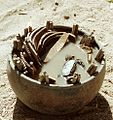| This article includes a list of general references, but it lacks sufficient corresponding inline citations. Please help to improve this article by introducing more precise citations. (August 2018) (Learn how and when to remove this message) |
| Ka-Tsepkye/Psikyɛ | |
|---|---|
 Home on the outskirts of Rhumsiki Home on the outskirts of Rhumsiki | |
| Total population | |
| 133,000 | |
| Regions with significant populations | |
| Mandara Mountains | |
| Cameroon | 111,000 |
| Nigeria | 22,000 |
| Languages | |
| Psikye | |
| Religion | |
| Traditional African religions, Islam | |
| Related ethnic groups | |
| other Kirdis | |
Kapsiki (Ka-Tsepkye) is a people living on both sides of the border between North Cameroon and Northeast Nigeria. They are called Kapsiki in Cameroon, and Kamwe (Higi) in Nigeria. Together they amount to about 120,000 people. Their language, Psekiye or Kamwe, consists of eleven dialects including Nkafa, Sina, Ghye, Humsi, Dakwa and Tilli and belongs to the Chadic language family.
In Cameroon, the Kapsiki live on a plateau in the Far North Province in the center of the Mandara Mountains. They are considered one of Cameroon's Kirdi (pagan) ethnic groups due to their resistance to Islamisation during the Fulani jihad of Modibo Adama and Hama Yaji.
In Nigeria, the Kamwe live on the slopes of the mountains and the western plain. The Kapsiki have been living in this area for five centuries, long before the great slave hunts of the 19th century, but by this isolated habitat they have been able to maintain themselves against the Fulbe. This also applies to the other peoples of Mandara region, such as the Mafa, Mofu, Podoko Guisiga, or Daba.
The mountain region has a kaleidoscope of local cultures. The Kapsiki live in villages of 2000-6000 people, and subsist on livestock farming, agriculture and - in the village of Rumsiki in particular - on tourism.
The Malima Project has been helping Kapsiki populations in Cameroon with educational projects aimed at primary schooling. The Malima Project has created a documentary and organized events to promote its educational activities in the area.
-
 Volcanic peaks in the Kapsiki region
Volcanic peaks in the Kapsiki region
-
 A woman outside Rhumsiki, 2004.
A woman outside Rhumsiki, 2004.
-
 Kapsiki women at the yearly festival
Kapsiki women at the yearly festival
-
 Crab divination by the Kapsiki
Crab divination by the Kapsiki
-
 Just initiated boys in Rumsu, Kapsiki, 1995.
Just initiated boys in Rumsu, Kapsiki, 1995.
References
- "Kapsiki". Joshua Project. Retrieved 22 February 2019.
- "La ONG Malima Project expone las fotografías de Elena López en la Casa de Cultura de Burjassot | elperiodic.com". elperiodic.com (in Catalan). 2012-02-12. Retrieved 2012-02-12.
- "La fotógrafa Elena López muestra en Burjassot (Valencia) la escuela creada por la ONG Malima en Camerún | www.20minutos.es". 20minutos.es (in Spanish). 2012-03-02. Retrieved 2012-03-02.
- Bibliography
- DeLancey, Mark W., and Mark Dike DeLancey (2000): Historical Dictionary of the Republic of Cameroon (3rd ed.). Lanham, Maryland: The Scarecrow Press.
- Van Beek, Walter E.A. (2012): The Dancing Dead. Ritual and Religion among the Kapsiki/Higi of North Cameroon and Northeast Nigeria, Oxford University Press.
- Van Beek, Walter E.A. (2013): Crab divination among the Kapsiki/Higi of North Cameroon and northeastern Nigeria' in Reviewing reality : dynamics of African divination Walter E.A. van Beek & Philip M. Peek, eds. Berlijn: LIT Verlag, p. 185-209.
- Kwache, Iliya Yame (2016): Kamwe People of Northern Nigeria: Origin, History and Culture. Prudent Universal Press and Publishing Company Ltd Kaduna Nigeria;
Further reading
- VAN BEEK, W. E. A. (1982). "'EATING LIKE A BLACKSMITH': SYMBOLS IN KAPSIKI ETHNO-ZOOLOGY". In DE JOSSELIN DE JONG, P.E.; SCHWIMMER, ERIK (eds.). Symbolic Anthropology in the Netherlands. Vol. 95. Brill. pp. 114–24. JSTOR 10.1163/j.ctvbqs310.9. Accessed 5 Dec. 2023.
- van Beek, Walter E.A. (2002). "Why a twin is not a child: symbols in Kapsiki birth rituals". Journal des africanistes. 72 (1): 119–147. doi:10.3406/jafr.2002.1290.
- van Beek, Walter E.A. (2017). The Transmission of Kapsiki-Higi Folktales over Two Generations: Tales That Come, Tales That Go. African Histories and Modernities. Palgrave Macmillan New York. doi:10.1057/978-1-137-59485-3. ISBN 978-1-349-95889-4.
- van Beek, Walter E. A. (2017a). "The Kapsiki Home Sacrifice". In Duyndam, Joachim; Et alli (eds.). Sacrifice in Modernity: Community, Ritual, Identity: From Nationalism and Nonviolence to Health Care and Harry Potter. Brill. pp. 17–32. JSTOR 10.1163/j.ctv2gjwtb8.5. Accessed 5 Dec. 2023.
This article about a Cameroonian ethnicity is a stub. You can help Misplaced Pages by expanding it. |